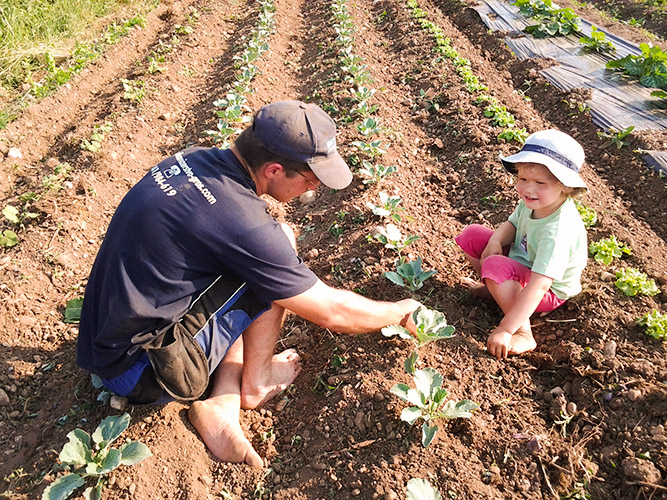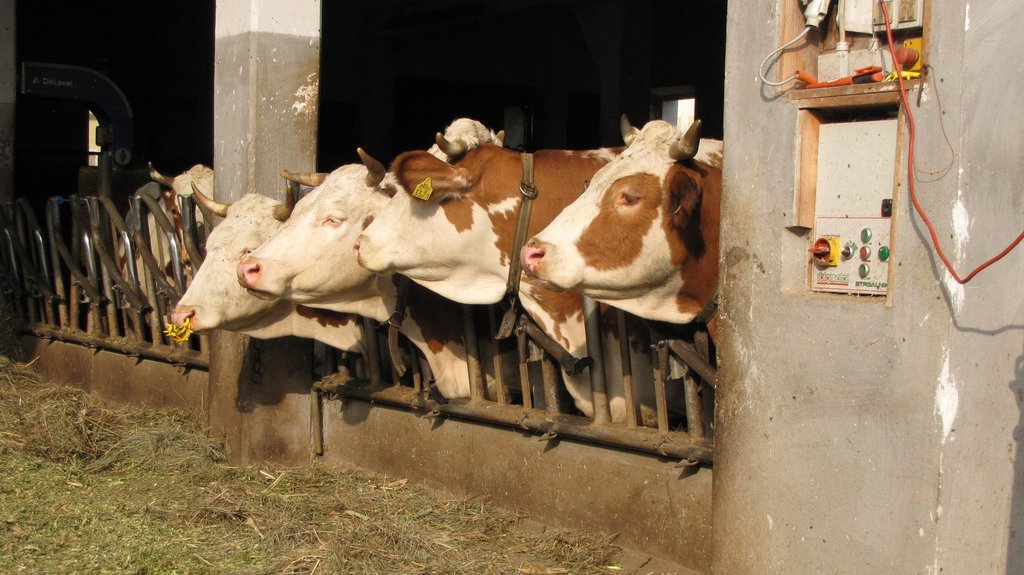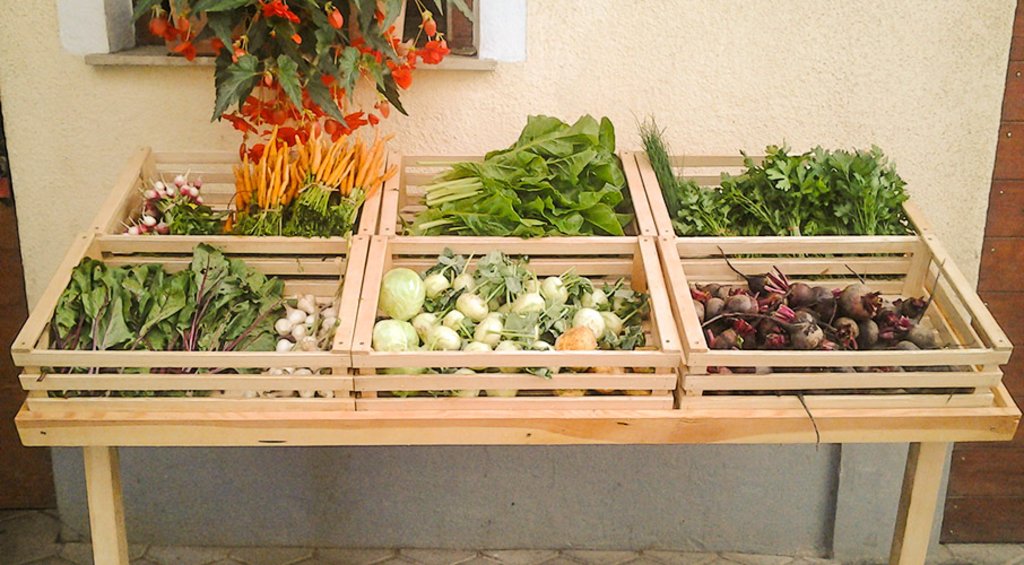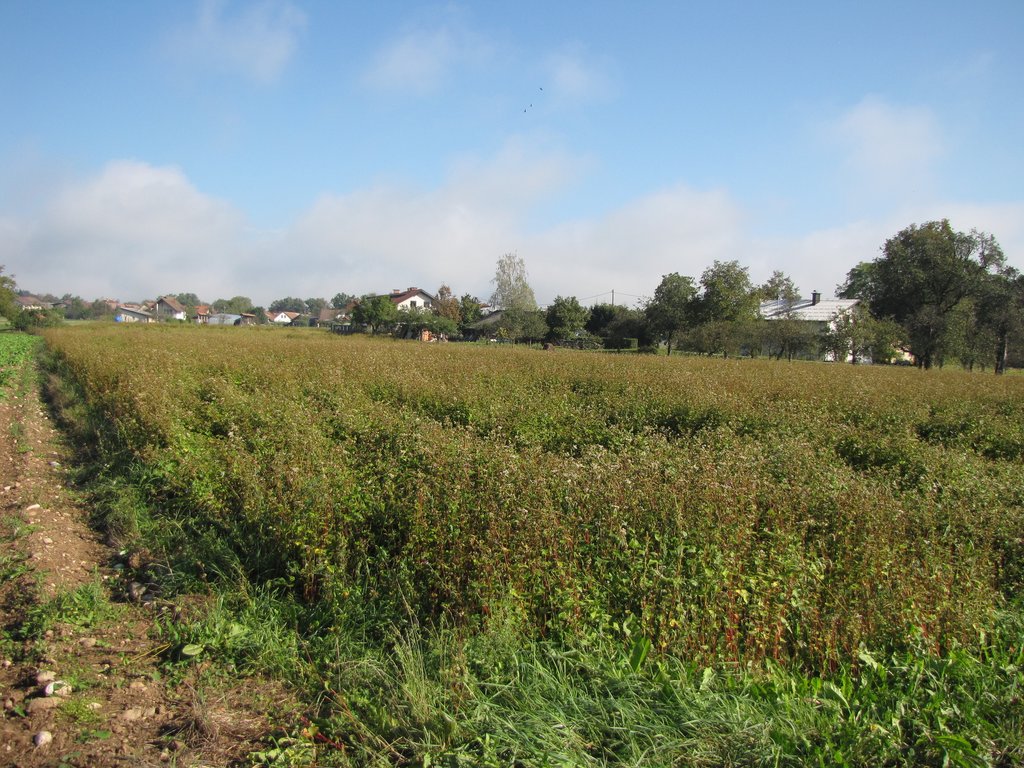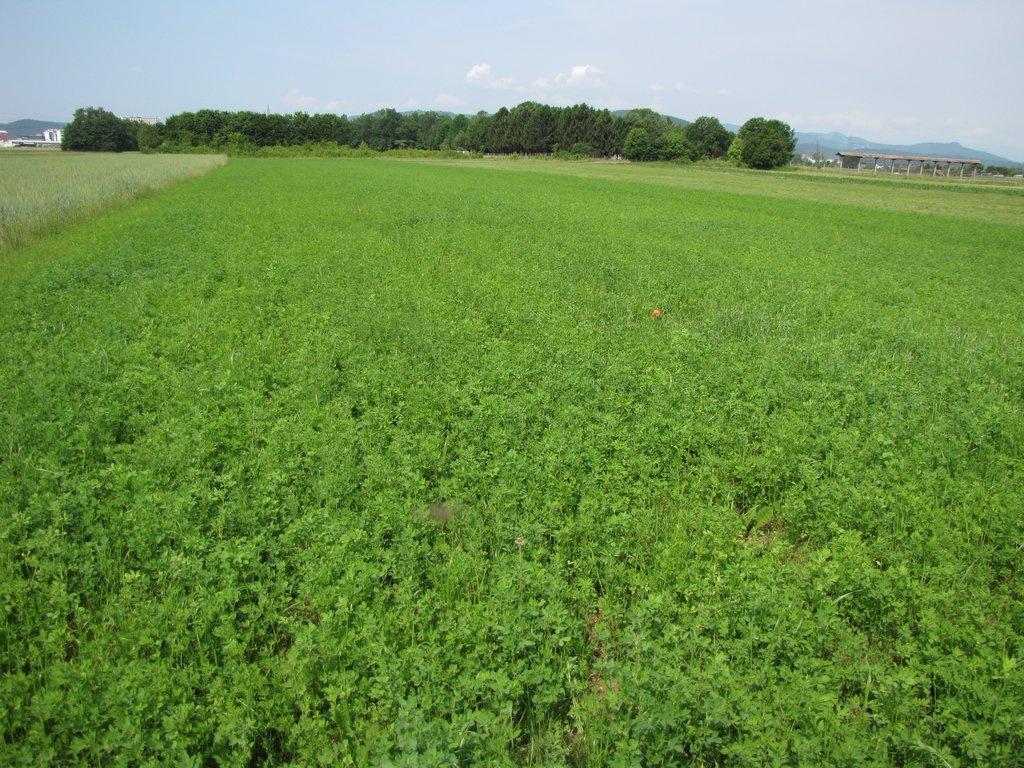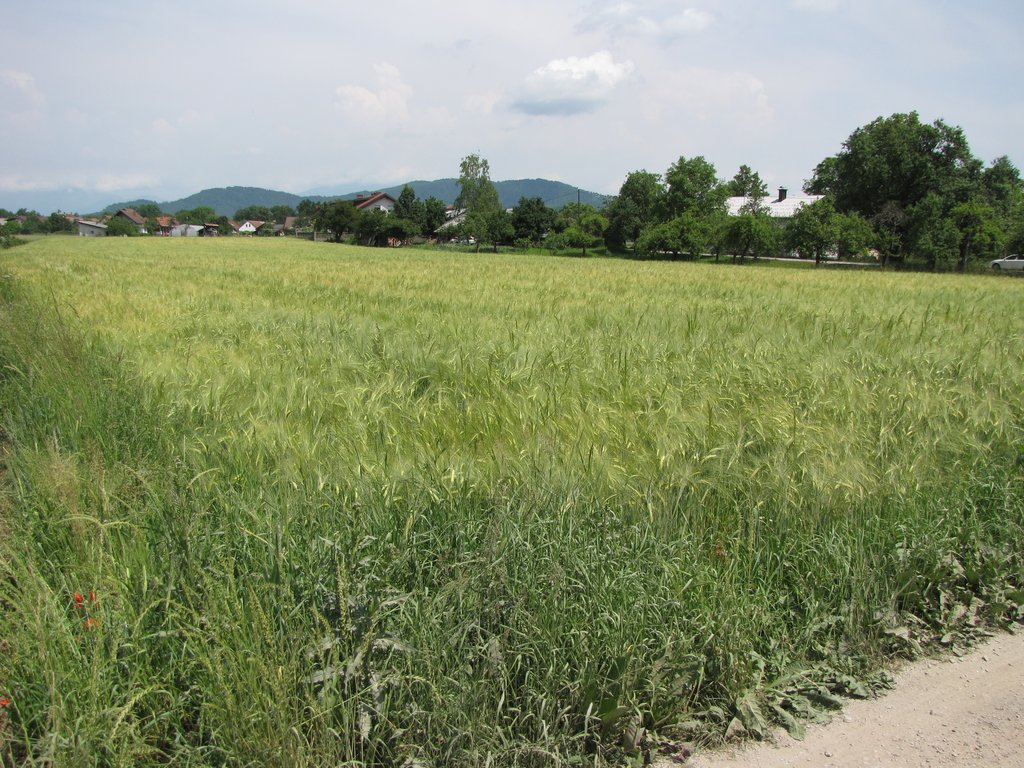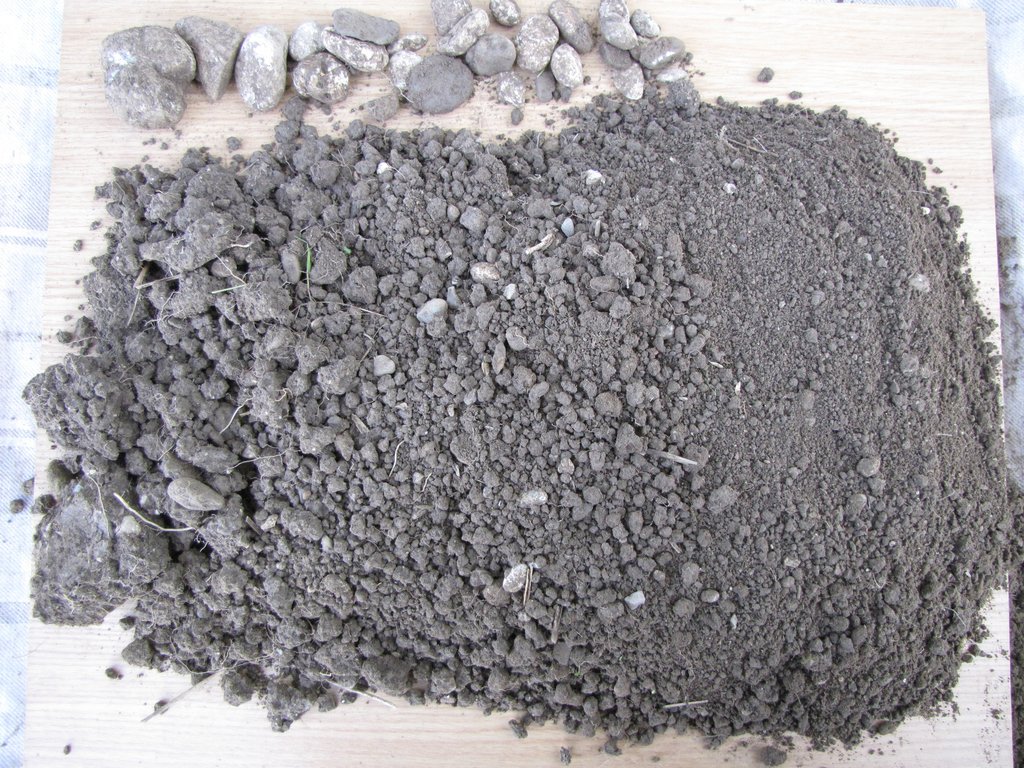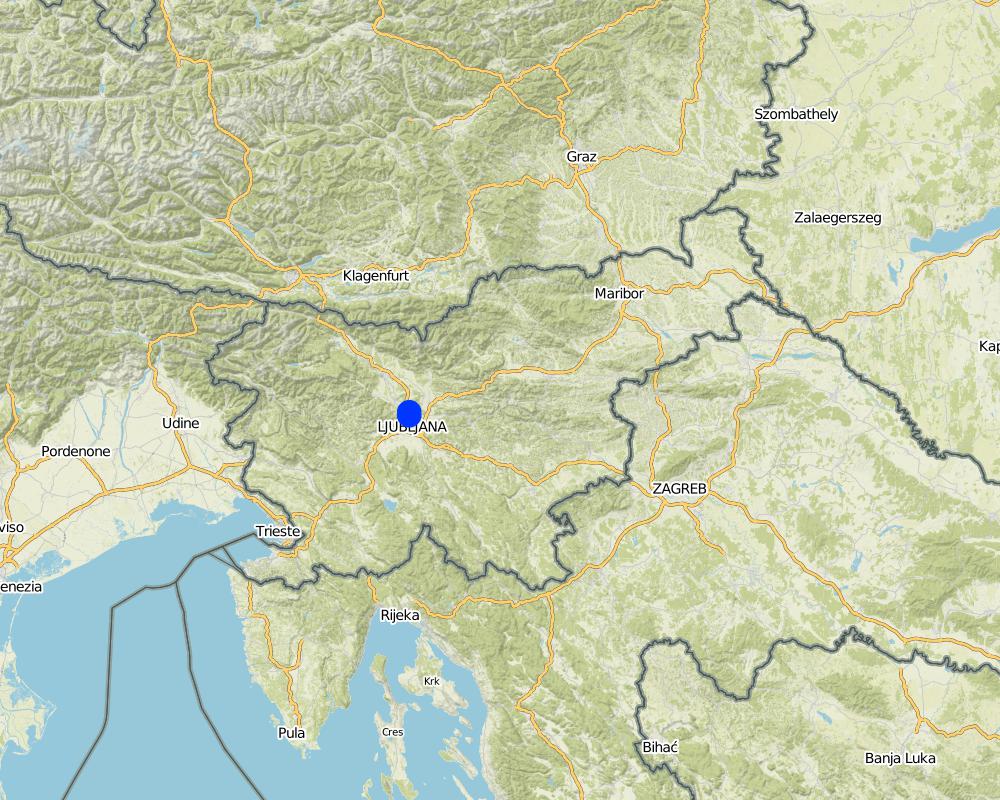Organic agriculture [Slovenia]
- Creation:
- Update:
- Compiler: Matjaz Glavan
- Editor: –
- Reviewers: Gudrun Schwilch, Ursula Gaemperli
Ekološko kmetijstvo
technologies_2795 - Slovenia
View sections
Expand all Collapse all1. General information
1.2 Contact details of resource persons and institutions involved in the assessment and documentation of the Technology
Name of project which facilitated the documentation/ evaluation of the Technology (if relevant)
Interactive Soil Quality assessment in Europe and China for Agricultural productivity and Environmental Resilience (EU-iSQAPER)Name of the institution(s) which facilitated the documentation/ evaluation of the Technology (if relevant)
Department for Agronomy, University of Ljubljana - Slovenia1.3 Conditions regarding the use of data documented through WOCAT
The compiler and key resource person(s) accept the conditions regarding the use of data documented through WOCAT:
Yes
1.4 Declaration on sustainability of the described Technology
Is the Technology described here problematic with regard to land degradation, so that it cannot be declared a sustainable land management technology?
No
2. Description of the SLM Technology
2.1 Short description of the Technology
Definition of the Technology:
It is based on 5 years crop rotation, full absence of artificial plant protection products and mineral nitrogen and the circulation of nitrogen via organic manure, crops and residues.
2.2 Detailed description of the Technology
Description:
1.The technology is applied in the flatlands of Ljubljana with an average altitude of 350 m.a.s.l. The average annual precipitation is 1400 mm. The area is characterized with often stormy precipitation events and occasional droughts. Silty loam soils in the area are moderately deep to deep with medium soil organic matter. Area has good availability of surface water and groundwater of good drinking quality. Area has medium biodiversity without salinity and flooding problems. Sedentary agriculture with mixed or commercial agriculture is practiced with less than 10 percemt from off-farm activities. The examined farm household has an average wealth and is mechanized/motorized. The farm is run by middle aged and elderly mens. The farm household has good access to all services and infrastructure. Farm is of medium scale with land partly owned by the land users and partly leased from other private owners.
2. Main characteristics are
(1) full 5 year crop rotation
(2) at least 0.5 livestock units
(3) circulation of nitrogen via organic manure
(4) cycle of other nutrients closed as much as possible
(5) absence of artificial plant protection products and mineral nitrogen.
(6) nitrogen fixation leguminous in crop rotation
(7) production of local traditional species (buckwheat)
3. Purpose of the technology is to manage the land in a sustainable way with closed nutrient cycles and to increase the biodiversity. Organic matter increases organic matter and fertility of the soils. Reduced soil acidificatino, pollution, salinization and alkalinization. Reduced soil compaction, slaking and crusting of soils. Increased bio-productive function of soils. Increased vegetation cover, biomass and improves habitats with better quantity of species and its composition and diversity. The purpose is also to offer customers food of local and well known products without any use of chemically based plant protection.
4. Major activities:
(1) keeping of farm animals in stables for closing the N-balance
(2) a lot of further manual farm and cultivation work. Some of it is replaced by new machinery. This causes additional costs at the moment of establishment
(3) regular manual checking for pests, diseases.
5. Benefits are the closed N cycle and the CO2 sequestration - high organic matter content, lower loss of nutrients, higher biodiversity.
6. Farm users dislike lots of costs connected with the new machinery, lots of paper work for the certification, the pressure on productivity, a great deal of work with planning crop rotations and nutrient management, coping with pests and diseases. But they like the better price on the market.
2.3 Photos of the Technology
2.5 Country/ region/ locations where the Technology has been applied and which are covered by this assessment
Country:
Slovenia
Further specification of location:
Municipality of Ljubljana
Specify the spread of the Technology:
- applied at specific points/ concentrated on a small area
Comments:
Georeferenced map locations are part of the same farm.
Only one farmer of the village is engaged in organic farming.
Map
×2.6 Date of implementation
Indicate year of implementation:
2008
If precise year is not known, indicate approximate date:
- less than 10 years ago (recently)
2.7 Introduction of the Technology
Specify how the Technology was introduced:
- through land users' innovation
- Common agricultural policy
Comments (type of project, etc.):
The land user saw the opportunity of capital city market and rising market of organic food in Slovenia. The subsidy payments accelerated the whole process of transformation from conventional to organic farm.
3. Classification of the SLM Technology
3.1 Main purpose(s) of the Technology
- reduce, prevent, restore land degradation
- conserve ecosystem
- preserve/ improve biodiversity
- create beneficial economic impact
- create beneficial social impact
3.2 Current land use type(s) where the Technology is applied
Land use mixed within the same land unit:
No

Cropland
- Annual cropping
Annual cropping - Specify crops:
- cereals - barley
- cereals - maize
- cereals - other
- cereals - wheat (winter)
- fodder crops - alfalfa
- legumes and pulses - peas
- root/tuber crops - potatoes
- vegetables - other
Number of growing seasons per year:
- 1

Grazing land
Intensive grazing/ fodder production:
- Cut-and-carry/ zero grazing
Animal type:
- cattle - dairy
Products and services:
- milk
Comments:
Main crops (cash and food crops): cereals (wheat, barley) / buckwheat / peas / alfalfa / corn / potato / vegetable / in winter cover crops
Main animal species and products: Dairy cows (milk, cheese). Due to the dispersed land parcels they are not able to implement grazing.
3.4 Water supply
Water supply for the land on which the Technology is applied:
- rainfed
Comments:
Vegetable on limited area is also irrigated.
3.5 SLM group to which the Technology belongs
- rotational systems (crop rotation, fallows, shifting cultivation)
- integrated soil fertility management
- integrated pest and disease management (incl. organic agriculture)
3.6 SLM measures comprising the Technology

agronomic measures
- A1: Vegetation/ soil cover
- A2: Organic matter/ soil fertility

management measures
- M2: Change of management/ intensity level
3.7 Main types of land degradation addressed by the Technology

chemical soil deterioration
- Cn: fertility decline and reduced organic matter content (not caused by erosion)
- Ca: acidification
- Cp: soil pollution

physical soil deterioration
- Pc: compaction
- Pk: slaking and crusting
- Pu: loss of bio-productive function due to other activities

biological degradation
- Bc: reduction of vegetation cover
- Bh: loss of habitats
- Bq: quantity/ biomass decline
- Bs: quality and species composition/ diversity decline
- Bl: loss of soil life
- Bp: increase of pests/ diseases, loss of predators
3.8 Prevention, reduction, or restoration of land degradation
Specify the goal of the Technology with regard to land degradation:
- prevent land degradation
- reduce land degradation
4. Technical specifications, implementation activities, inputs, and costs
4.1 Technical drawing of the Technology
Technical specifications (related to technical drawing):
Infographic presents main activities taken place under organic farming technology (rotation, weed and pest control, animal welfare and use of organic fertilisers) . All of them finally result in benefits at the bottom of figure (local market, known origin of food, healthy food, food self-sufficiency).
Author:
Matjaž Glavan
Date:
02/08/2017
4.2 General information regarding the calculation of inputs and costs
Specify how costs and inputs were calculated:
- per Technology area
Indicate size and area unit:
24 hectares
other/ national currency (specify):
EUR
Indicate average wage cost of hired labour per day:
50 EUR
4.3 Establishment activities
| Activity | Timing (season) | |
|---|---|---|
| 1. | Exclusion of artificial chemiclas (plant protection products) | all year around |
| 2. | Only organic N in use | all year around |
| 3. | 5 year rotation | all year arround |
| 4. | Winter cover crops | in autumn, winter |
| 5. | Working with papers, records | all year around |
| 6. | Animal stall reconstruction | first year |
| 7. | machinery (cultivator, grubber, harrows) | first three years |
| 8. | Plant protection preparations (for diseases and pests) | First year |
| 9. | Further cost for diverse supplement activities (50% more work) | all year around |
4.4 Costs and inputs needed for establishment
| Specify input | Unit | Quantity | Costs per Unit | Total costs per input | % of costs borne by land users | |
|---|---|---|---|---|---|---|
| Labour | Working with papers, records | hour | 20.0 | 6.25 | 125.0 | 20.0 |
| Labour | Further cost for diverse supplement activities | hour | 700.0 | 6.25 | 4375.0 | 100.0 |
| Equipment | machinery (cultivator, grubber, harrows) | pcs | 3.0 | 4000.0 | 12000.0 | 100.0 |
| Fertilizers and biocides | Copper preparations (diseases) | ml | 100.0 | 0.2 | 20.0 | 100.0 |
| Fertilizers and biocides | Naturalis (potato, vegetable) (Beauveria bassiana) | ml | 100.0 | 0.2 | 20.0 | 100.0 |
| Fertilizers and biocides | Neemezal (potato, vegetable) | ml | 100.0 | 0.2 | 20.0 | 100.0 |
| Construction material | Animal stall reconstruction | pcs | 1.0 | 60000.0 | 60000.0 | 100.0 |
| Other | Regular certifiaction control for organic production | pcs | 1.0 | 400.0 | 400.0 | |
| Total costs for establishment of the Technology | 76960.0 | |||||
| Total costs for establishment of the Technology in USD | 76960.0 | |||||
4.5 Maintenance/ recurrent activities
| Activity | Timing/ frequency | |
|---|---|---|
| 1. | Working with papers, records | all year around |
| 2. | Equipment maintenance | all year around |
| 3. | Only organic N in use | all year around |
| 4. | Winter cover crops | autumn, winter |
| 5. | 5 year rotation | all year around |
| 6. | Buying plant protection products | all year around |
| 7. | Further cost for diverse supplement activities (35% more work) | all year aroud |
4.6 Costs and inputs needed for maintenance/ recurrent activities (per year)
| Specify input | Unit | Quantity | Costs per Unit | Total costs per input | % of costs borne by land users | |
|---|---|---|---|---|---|---|
| Labour | Working with papers, records | hour | 20.0 | 6.25 | 125.0 | 100.0 |
| Labour | Further cost for diverse supplement activities | hour | 490.0 | 6.25 | 3062.5 | 100.0 |
| Equipment | regular maintenance of machinery | hour | 1.0 | 50.0 | 50.0 | 100.0 |
| Fertilizers and biocides | Copper preparations (diseases) | ml | 100.0 | 0.2 | 20.0 | 100.0 |
| Fertilizers and biocides | Naturalis (potato, vegetable) (Beauveria bassiana) | ml | 100.0 | 0.2 | 20.0 | 100.0 |
| Fertilizers and biocides | Neemazal (potato, vegetable) | ml | 100.0 | 0.2 | 20.0 | 100.0 |
| Other | Regular certifiaction control for organic production | pcs | 1.0 | 400.0 | 400.0 | |
| Total costs for maintenance of the Technology | 3697.5 | |||||
| Total costs for maintenance of the Technology in USD | 3697.5 | |||||
If land user bore less than 100% of costs, indicate who covered the remaining costs:
The reamining costs are coverd by subsidy payments.
4.7 Most important factors affecting the costs
Describe the most determinate factors affecting the costs:
Labour availability, price of organic plant protection products and fertilisers, price of the machinery
5. Natural and human environment
5.1 Climate
Annual rainfall
- < 250 mm
- 251-500 mm
- 501-750 mm
- 751-1,000 mm
- 1,001-1,500 mm
- 1,501-2,000 mm
- 2,001-3,000 mm
- 3,001-4,000 mm
- > 4,000 mm
Specify average annual rainfall (if known), in mm:
1352.00
Specifications/ comments on rainfall:
Average annual period (1991-2000)
Majority of rainfall in autumn, followed by summer, spring and winter.
Indicate the name of the reference meteorological station considered:
Ljubljana - Bežigrad
Agro-climatic zone
- sub-humid
Strong summer tunder storms, showers, local precipitation.
5.2 Topography
Slopes on average:
- flat (0-2%)
- gentle (3-5%)
- moderate (6-10%)
- rolling (11-15%)
- hilly (16-30%)
- steep (31-60%)
- very steep (>60%)
Landforms:
- plateau/plains
- ridges
- mountain slopes
- hill slopes
- footslopes
- valley floors
Altitudinal zone:
- 0-100 m a.s.l.
- 101-500 m a.s.l.
- 501-1,000 m a.s.l.
- 1,001-1,500 m a.s.l.
- 1,501-2,000 m a.s.l.
- 2,001-2,500 m a.s.l.
- 2,501-3,000 m a.s.l.
- 3,001-4,000 m a.s.l.
- > 4,000 m a.s.l.
Indicate if the Technology is specifically applied in:
- not relevant
5.3 Soils
Soil depth on average:
- very shallow (0-20 cm)
- shallow (21-50 cm)
- moderately deep (51-80 cm)
- deep (81-120 cm)
- very deep (> 120 cm)
Soil texture (topsoil):
- coarse/ light (sandy)
- medium (loamy, silty)
Soil texture (> 20 cm below surface):
- coarse/ light (sandy)
Topsoil organic matter:
- medium (1-3%)
5.4 Water availability and quality
Ground water table:
5-50 m
Availability of surface water:
good
Water quality (untreated):
good drinking water
Is water salinity a problem?
No
Is flooding of the area occurring?
No
5.5 Biodiversity
Species diversity:
- medium
Habitat diversity:
- medium
5.6 Characteristics of land users applying the Technology
Sedentary or nomadic:
- Sedentary
Market orientation of production system:
- mixed (subsistence/ commercial)
Off-farm income:
- less than 10% of all income
Relative level of wealth:
- average
Individuals or groups:
- individual/ household
Level of mechanization:
- mechanized/ motorized
Gender:
- women
- men
Age of land users:
- middle-aged
- elderly
5.7 Average area of land used by land users applying the Technology
- < 0.5 ha
- 0.5-1 ha
- 1-2 ha
- 2-5 ha
- 5-15 ha
- 15-50 ha
- 50-100 ha
- 100-500 ha
- 500-1,000 ha
- 1,000-10,000 ha
- > 10,000 ha
Is this considered small-, medium- or large-scale (referring to local context)?
- medium-scale
5.8 Land ownership, land use rights, and water use rights
Land ownership:
- individual, titled
Land use rights:
- leased
- individual
Water use rights:
- individual
5.9 Access to services and infrastructure
health:
- poor
- moderate
- good
education:
- poor
- moderate
- good
technical assistance:
- poor
- moderate
- good
employment (e.g. off-farm):
- poor
- moderate
- good
markets:
- poor
- moderate
- good
energy:
- poor
- moderate
- good
roads and transport:
- poor
- moderate
- good
drinking water and sanitation:
- poor
- moderate
- good
financial services:
- poor
- moderate
- good
6. Impacts and concluding statements
6.1 On-site impacts the Technology has shown
Socio-economic impacts
Production
crop production
Comments/ specify:
Production in comparison with conventional production is lower by at least 20 percent. As chemical plant protection is not applied the production can not be raised. And the cows eat only fodder coming directly from farm production without buying concentraded feed.
crop quality
fodder production
Comments/ specify:
They do not use mineral fertilizers. Thus, fodder quantity decreased slightly
fodder quality
animal production
Comments/ specify:
Organic technology requires the dairy cows stall reconstruction. On the same area only half can be kept compared to the conventional dairy.
risk of production failure
Comments/ specify:
Plant diseases or pests can develop very rapidly and if it can't be addressed in its early stage it can destroy the yield. Sometime it happens, when nothing succeeds.
product diversity
land management
Comments/ specify:
Farmer is saying that every technology has its pluses and minuses and on general he doesn't observe differences. It is never simple.
Water availability and quality
drinking water quality
Income and costs
expenses on agricultural inputs
Comments/ specify:
The plant protection products and organic fertilisers and organic seeds are more expensive.
farm income
Comments/ specify:
Due to regular customers, the location near the capital city and good prices income increases for 50% . Three persons are fully employed.
diversity of income sources
Comments/ specify:
When they started with organic farming they started to produce dairy products (yogurt, cheese), flour and bread and vegetable. Before they produced only raw milk.
workload
Comments/ specify:
A lot of hand/manual work in the field or at production of dairy product or bread.
Socio-cultural impacts
food security/ self-sufficiency
health situation
Ecological impacts
Water cycle/ runoff
water quality
Soil
soil accumulation
soil organic matter/ below ground C
Biodiversity: vegetation, animals
plant diversity
beneficial species
habitat diversity
pest/ disease control
Climate and disaster risk reduction
drought impacts
emission of carbon and greenhouse gases
6.2 Off-site impacts the Technology has shown
groundwater/ river pollution
6.3 Exposure and sensitivity of the Technology to gradual climate change and climate-related extremes/ disasters (as perceived by land users)
Gradual climate change
Gradual climate change
| Season | increase or decrease | How does the Technology cope with it? | |
|---|---|---|---|
| annual temperature | increase | not known | |
| seasonal temperature | summer | increase | not known |
6.4 Cost-benefit analysis
How do the benefits compare with the establishment costs (from land users’ perspective)?
Short-term returns:
neutral/ balanced
Long-term returns:
positive
How do the benefits compare with the maintenance/ recurrent costs (from land users' perspective)?
Short-term returns:
neutral/ balanced
Long-term returns:
positive
Comments:
It is important that land user is engaged on market with self-promotion and good quality of product.
6.5 Adoption of the Technology
- single cases/ experimental
Of all those who have adopted the Technology, how many did so spontaneously, i.e. without receiving any material incentives/ payments?
- 91-100%
Comments:
It is self-initiated as farm has its land on a water protection zone with many restrictions in management.
6.6 Adaptation
Has the Technology been modified recently to adapt to changing conditions?
No
6.7 Strengths/ advantages/ opportunities of the Technology
| Strengths/ advantages/ opportunities in the land user’s view |
|---|
| Lower use of plant protection products - less impact on bidiversity and water sources. |
| Quality of products. |
| Demand over organic food on the market is high, Farm is close (1 km) to capital city market. |
| Strengths/ advantages/ opportunities in the compiler’s or other key resource person’s view |
|---|
| Food produced without chemicals is of better quality and more interesting for the market. |
6.8 Weaknesses/ disadvantages/ risks of the Technology and ways of overcoming them
| Weaknesses/ disadvantages/ risks in the land user’s view | How can they be overcome? |
|---|---|
| Working force, especialy in vegetable production | New machinery, rotation |
| Shortage of nitrogen | fabaceae (legumes) as part of crop rotation |
| Weaknesses/ disadvantages/ risks in the compiler’s or other key resource person’s view | How can they be overcome? |
|---|---|
| A lot of work force and expensive specialized machinery needed. | This is part of this technology. This can be overcome with higher prices of products. |
7. References and links
7.1 Methods/ sources of information
- field visits, field surveys
1
- interviews with land users
1
When were the data compiled (in the field)?
31/05/2017
Links and modules
Expand all Collapse allLinks
No links
Modules
No modules


